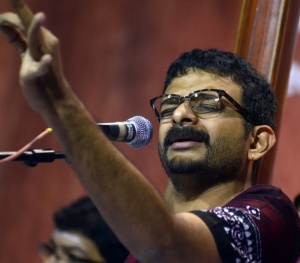Krishna, you have said that you wait and long for the day when a dalit will perform at the music academy. Are you suggesting that the world of Carnatic music is not inclusive enough?
Oh! I am not suggesting, that’s a fact.
This is an excerpt from the interview conducted by T.S. Sudhir of Headlines Today with T.M. Krishna on 3 January after the release of Krishna’s book ‘A Southern Music-The Karnatic Story’. This interview left me thinking on whether the music world I adore and grew up with was after all not all that pure and divine. T.M. Krishna is one of the most loved performers in the Carnatic scene. His mellifluous voice, deep understanding of the ragas and his experiments with them have garnered him accolades and respect. So, to hear the above statement from him was indeed shocking. I mulled over this for a while but then other commitments kept me busy and I had completely forgotten about it.
But then time has strange ways to connect us to the past, and that’s how I found myself waiting for T.M. Krishna’s arrival on 24 July at MIDS, Adyar (3:30 PM, to be precise). And obviously you guessed it right, the topic of his lecture was- Imbalances in Carnatic music. Over the next hour and a half he left the audience spellbound with his scholarly insights into the many problems that plague the classical scene.
He started with how various instrumentalists are placed on the stage and stressed the fact that hierarchy decided where one sat. The lead singer was centrally placed, the Pakhavadyams i.e. violinist to his left, mridangist on his right; the ‘upa’ pakhavadyams- Kanjira, Ghatam and tambura were behind the main artist. This hierarchy according to him is the sacred rule of stage placement, none changed his ‘sthnam’ for the other as it is taken as an insult to their mastery, thereby making them inferior to the other instrumentalist. This hierarchy determines the payment of the various artists too. The ‘lower’ one is, the lesser he/she gets paid.
The talk then shifted towards gender bias, but beware, this is not your usual man vs. woman debate, this bias operates on a whole new level. Tackle this fact for starters- Many woman singers DO NOT want a woman violinist to play for them. T.M.K believes the reason for strange phenomenon could be the fact that the woman feels ‘powerful and dominant’ when men surround her and ‘play to her tunes’. The question now arises- What about female mridangists or ghatam players? But then ‘tradition’ has an answer. It is considered to be ‘visually vulgar’ for a woman to play a mridangam or a ghatam. Such is the sorry state that we have locked ourselves in.
It does not end there, T.M. Krishna also took on caste to make his point. He reminded the audience that the two main dominating castes in music were the Devadasis and the Brahmins, but now, only the Brahmin style of music has survived, thanks to the patronage of various sabhas to this particular style. Krishna strongly believes that we have lost a great deal of musical knowledge because of the ‘Devadasi’ loss. He even explained that the role of other castes has never been acknowledged. For example, the Christian Dalits who fabricate the mridangam are hardly ever given their due.
The Brahmins are all dominant and yes, there is no proof to say that they have stopped people from other caste or religion from entering the musical scene. But then it is the perception and tradition that we have to break. To the practitioner’s credit, many of them have tried their level best to take classical music to the wider audience, but the perception still lingers- you have to be a ‘high’ caste to sing. Maybe breaking these traditional biases and barriers and encouraging upcoming artists from all sections will do us a whole lot of good. At the end of the day, music is what matters, not who sings. We are all born equal and art is for all. Kudos for that invigorating lecture T.M.K and hopefully a day will come when your dream will come true.
“Sweetness and strength, pleasure with surprise, an energy of conception which seems at every moment about to break through all comely form, recovering, touch by touch, a loveliness found usually only in the simplest natural things- ex forti dulcedo.” This is what Walter Pater had to say about Michelangelo’s art in his book ‘The Renaissance- Studies in art and poetry’, way back in 1873. Maybe it holds true for classical music too.
Picture Courtesy: http://www.kutcheris.com
